Contents
There is another plant that is consonant with freesia – this is Frizeya (wrong interpretation – Vriesia). Our heroine freesia comes from wild African bulbous plants and got its name from the name of the German doctor Fried Frese then, as in Friesei Hispanic roots, and it belongs to a completely different genus of plants. In Europe and Asia, freesia has become widespread thanks to the Netherlands, a state with a thriving flower business. Our flower growers living in the middle lane, and even in Siberia, have many questions related to planting and growing these flowers in the open field.
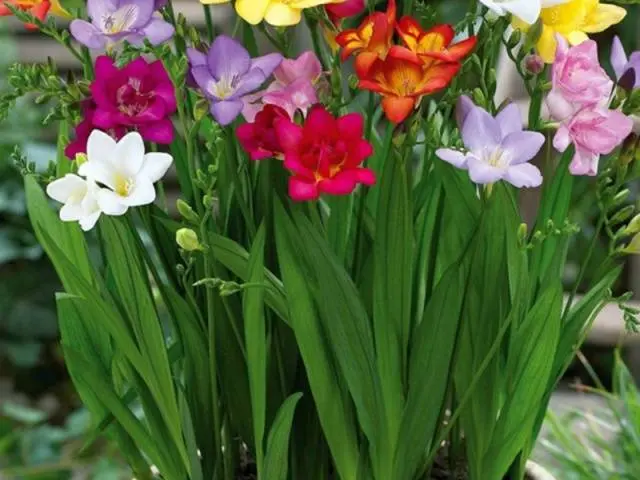
Fragrant beauty from Africa
Walking along the alleys of city parks in Siberia, the Urals or the Volga region, admiring the beauty of flowers in the flower beds, an ignorant person cannot even imagine that freesia is a representative of the African flora. It tolerates our climatic conditions remarkably, the aroma of freesia in our land is as strong as in Africa. Such a miracle will be a wonderful decoration for your flower beds: at home, on the balcony, in summer cottages and in manor greenhouses.
Morphology

The structure and shape of freesias of all varieties differ little from each other, the main differences can be in the color and shape of flowers, as well as in the height of the stem of the plant. In the photo you see a copy of ordinary freesia, according to the botanical description, the plant is divided into the following parts:
- freesia roots – a corm of medium size from 2 to 7 or more centimeters, in the process of growth, small outgrowths-babies are formed on the bulb, which are easily separated from the mother tuber, but can exist side by side as an independent plant for as long as you like. They grow according to the principle “in close quarters, but not offended”, this situation is typical for freesia plantings, they love close contacts;
- freesia leaves – grow directly from the bulb, hatching from scales, in a short time (1-2 weeks) reach a length of 15-30 cm, narrow (1-2 cm), there is a pronounced vein in the center of the leaf, prone to lodging, so a garter is needed to the support, the color of the leaves is natural green shades;
- freesia stems – thin and bare, their height can vary depending on the variety from 20 to 75 cm (sometimes up to 1 m), strongly branched at the top, several peduncles (2-12 pieces) nest in succession on outgoing stems;
- flowers – medium size, shaped like a funnel on a narrow neck, the number of petals is from 6 to 10 pieces, inside the funnel the color of the flowers is of a contrasting color, which differs sharply from the main color of the petals, but there are a monochrome palette: pure white, plain blue, yellow, the flowers are very fragrant, fragrant with an aroma reminiscent of the smell of lily of the valley;
- freesia fruits – small seed pods with dark brown seeds.
More than 150 varieties and hybrids of this plant have been bred since the beginning of breeding work, there are different types for growing freesia at home, in open ground, in greenhouses and greenhouses, the color of the flowers is so diverse that when choosing, the eyes get tired of their brightness and color.
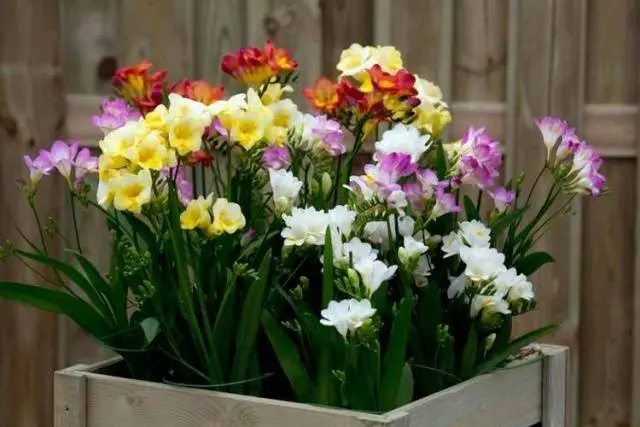
Sorts
We are not able to describe all the existing varieties and hybrids of freesia, it is simply impossible, but we will still tell you something about some of their brightest representatives.
Cardinal – flower petals are painted red-orange, the flower funnel is yellow with dark lines, there are 9-11 inflorescence nests on the peduncle.
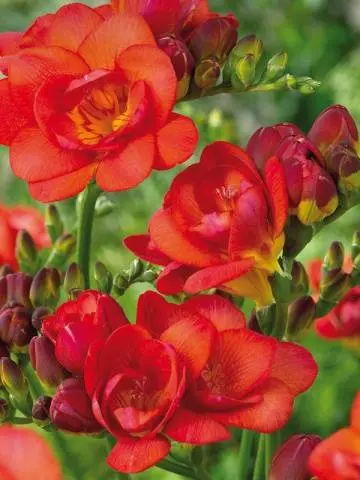
Freesia Armstrong – coloring of flowers in red-pink tones, the height of the stem of the plant reaches 70 cm.
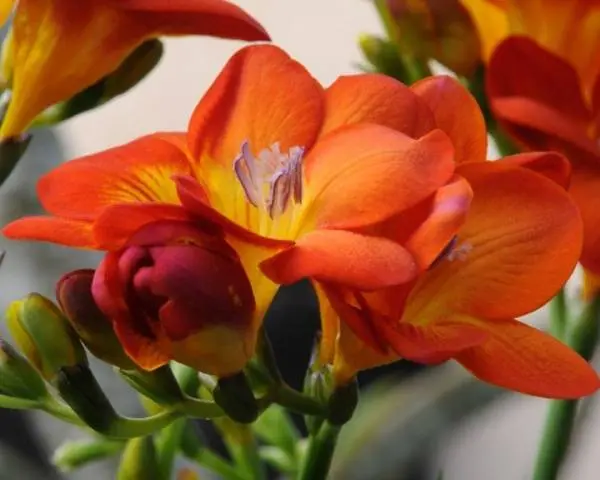
Ballerina – the flowers are painted snow-white with yellow spots inside the funnel and on the petals, up to 12 flowers are formed on the inflorescences.
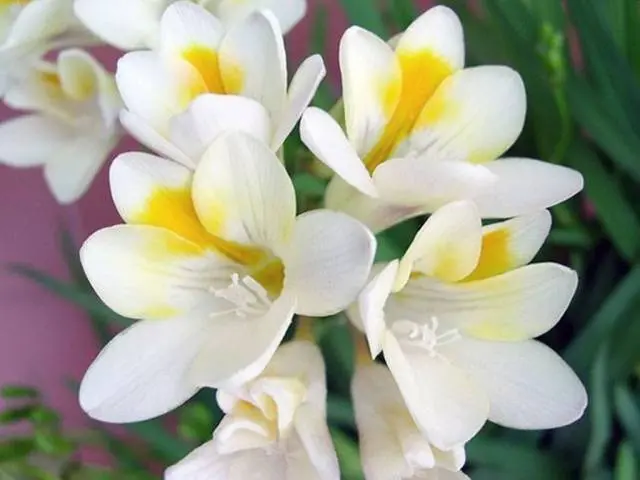
Rose Marie – the color is pale pink, crimson, the inside of the funnel is white with pink veins, the number of flowers on the peduncle is up to 7 pieces.
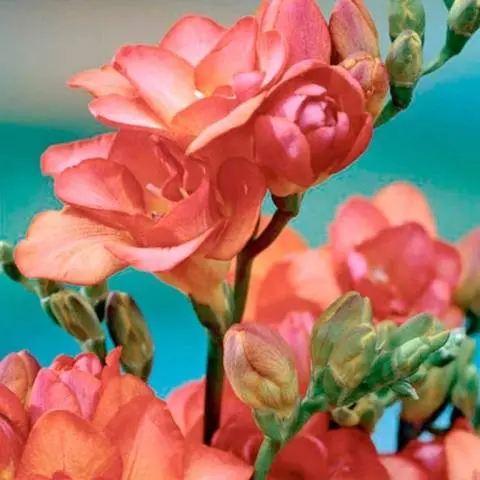
Pimperina – a low plant (up to 20 cm), white flower petals are covered with yellow spots, the aroma is weak.
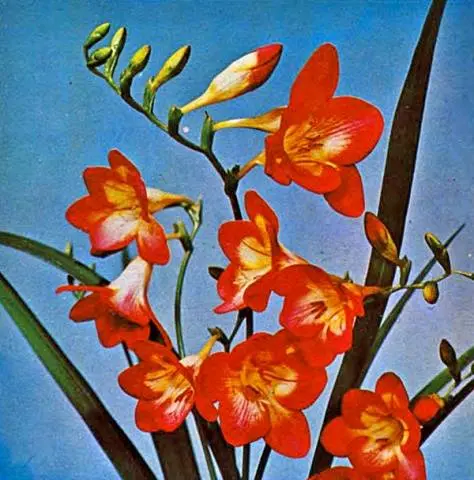
Alba – large snow-white flowers are covered with slightly noticeable purple touches.
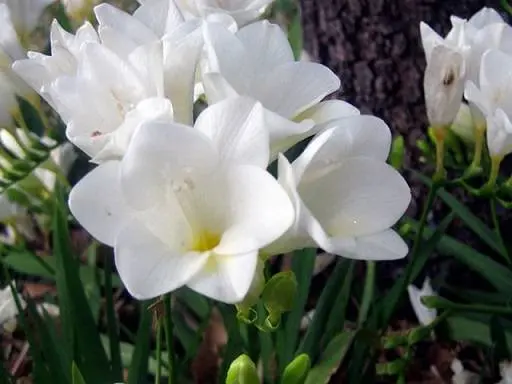
Fragrant freesia – yellow, almost monochrome, the color of the petals, only inside the funnel there is a small yellow-orange speck, it is fragrant with a lily-of-the-valley aroma.
How to grow freesia in the garden
Growing freesia in open ground is a very simple process, you just need to follow the most basic rules of planting and care. This bulbous plant is sure to bloom and fill the air in your gardens with a sweet fragrant aroma.
Preparing and planting bulbs
The first step is the preparation of planting material.
- Freesia bulbs must be carefully inspected after opening the package.
- Remove all dried and rotten (if any) specimens.
- Clean the bulb from freely separating scales, do not remove the upper part adjacent to the nest, free the lower part from dirt and dry earth.
- For disinfection and disease prevention, place the bulbs for 30 minutes in a fungicide solution.
- Prepare containers (you can take simple plastic cups or special pots for seedlings), fill them halfway with loose earth.
- Place 3 freesia bulbs in one container, slightly pressing into the substrate, add soil so that it covers the entire lower part, pour water. After shrinkage of the earth, add more substrate.
- Put the container in a warm, but not hot place for germination.
This operation begins in the spring 2-4 weeks before planting in open ground, if such a planting is planned for the end of May, then the bulbs can be planted in mid-late April. Watch the video recommendations of an experienced grower, she tells and shows how to prepare and plant freesia bulbs for germination.
Care of seedlings
During the month when freesia bulbs are germinating, they need the following care:
- watering – after 1-3 days, once a week, combine it with top dressing, additives to stimulate root growth, soil disinfection (potassium permanganate);
- disease prevention – in 2 weeks, spray 1 time with special solutions of fungicides (from powdery mildew);
- necessary conditions for the normal growth of freesia – in case of insufficient lighting (slow growth of leaves), place the containers closer to the light, with excess sun and high air temperature (rapid growth), rearrange the pots in a cooler and darker place;
- hardening freesia – two weeks after planting the bulbs, or 10-12 days before planting in open ground, daily take containers with seedlings outside, onto a balcony or other place protected from drafts for hardening. Time – start with 30 minutes, gradually increasing it until the night hours.
The beginner grower tells about his way of caring for freesia and the mistakes made in this process in the attached video. Watch it and try not to make such mistakes.
Landing in the ground
In the spring, when the threat of frost on the soil has passed, at the end of April and until the end of May, freesias can be planted in open flower beds and flower beds, not forgetting that the plant loves warmth, so you need to prepare an insulating coating, at least for 2-3 weeks, while freesia will adapt to the conditions in the new location. Our boarding recommendations:
- the soil – should be very loose, well aerated for water and air, fertile, low acid, usually the ground is fertilized a year before planting, then this is not necessary in the spring, if the soil is not prepared, then all fertilizers: organics and minerals are applied a month before planting , the earth is carefully dug up and loosened several times;
- landing depth – germinated bulbs should be planted to a depth of no more than 15-20 cm, put 3 seedlings side by side, sprinkle with earth, shed and mulch with peat or dry compost;
- family plantings – a characteristic feature in the cultivation of freesia is close plantings, three-onion families are seated very close, no further than 10-15 cm from each other, at such a distance they feel great and can support leaves and stems of neighboring plants that are prone to drooping;
- supports and racks – leaves and stems of very tall freesias (up to 70 cm) as they grow, will need to be strengthened on racks and small trellises, it is better to prepare them in advance;
- warming – in case of sudden cold snaps and cool night hours, prepare low brackets-holders and PVC film.
You will receive a practical lesson on how to plant freesias in open ground by additionally watching a useful video.
Features of cultivation in Siberia
There are no radical differences in growing freesia in Siberian conditions, or almost none, but it can be noted:
- Bulbs for germination are planted not at the end of April, but 2 weeks earlier.
- They are planted in open ground later, at the end of May, in June.
- For the winter, the bulbs are dug up at the end of autumn, and stored in basements and insulated sheds until spring.
These are very minor differences in landing time. Freesias bloom in Siberia in the same way as in other, less severe regions of the country, until the coldest autumn days.
Use in garden design
In the garden, you can create unique compositions of freesias of different varieties. Delicate or bright in color, a wall of these colors will decorate any corner, garden path or gazebo. These plants give the designer a wide avenue for their fantasies, and not only for professionals, but also for ordinary flower growers, freesia is an inexhaustible well of beauty and divine aroma.
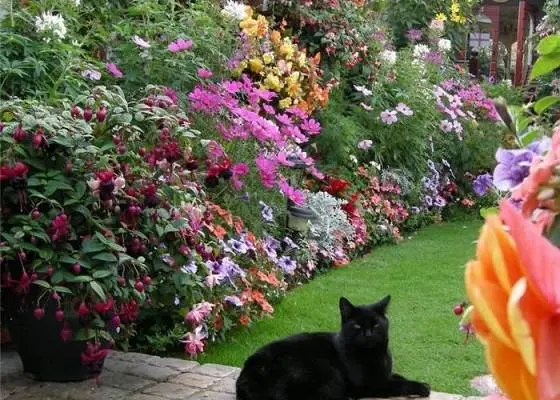
Conclusion
Grow freesias, these are flowers for the heart and soul, live happily ever after, and if we missed something in our tips, watch another video that combines all this information. Good luck.









